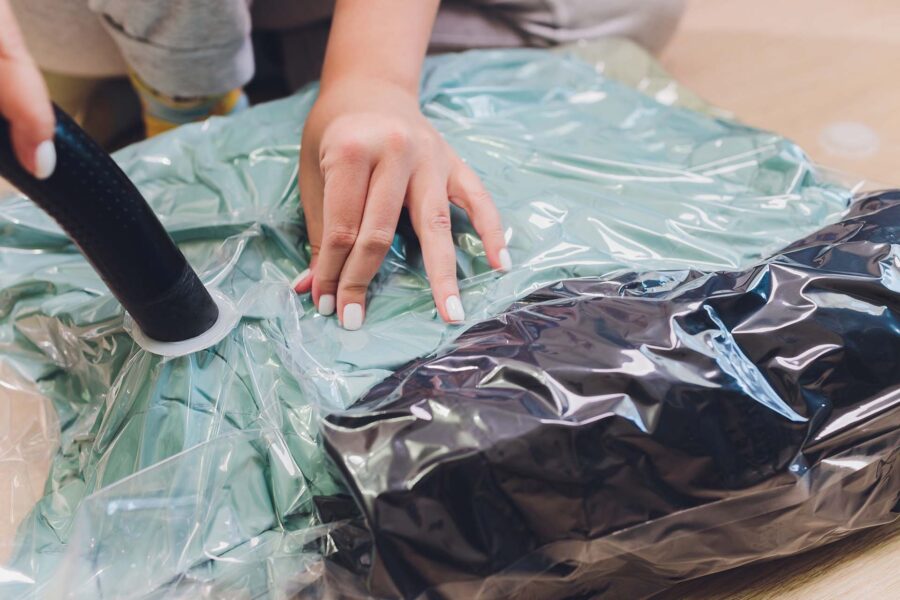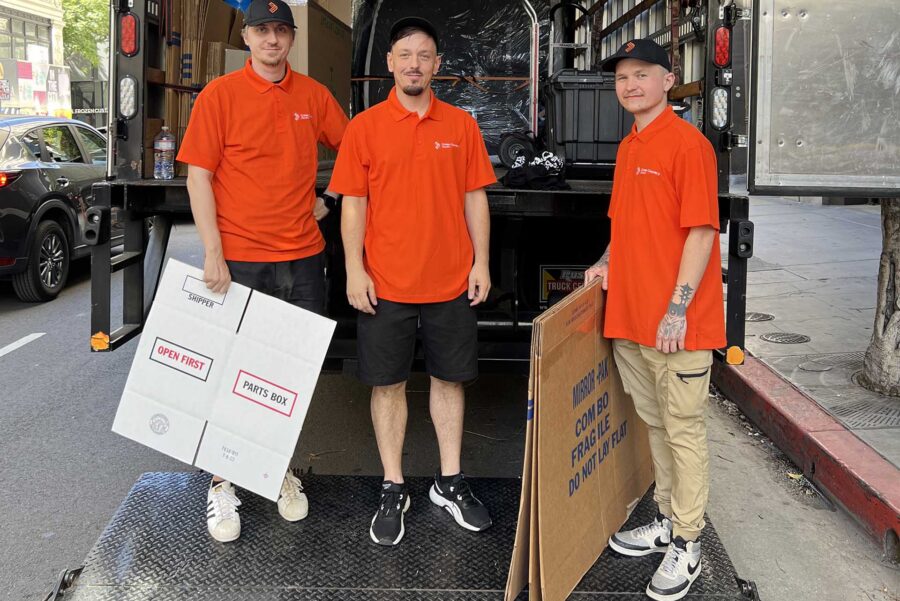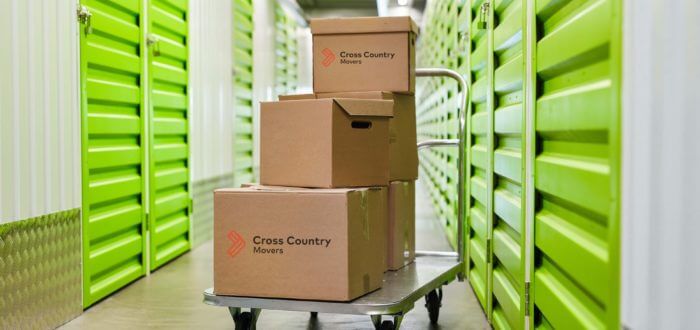

Master the Art of Packing – How to Pack Blankets for Moving Like a Pro
Posted in How-to on June 14, 2024
As you prepare to embark on this journey, amidst the chaos of boxes and logistics, there lies a quiet yet significant task – packing quilts securely. These seemingly simple pieces of fabric hold memories, offer comfort, and carry the essence of home. So, how to pack blankets for moving and preserve their physical form throughout this transfer? Let’s find out!
How to Pack Blankets for Moving Cross-Country
When moving across the country, try to stay calm and organized. The best way to pack for a move is by exploring the boxing-up needs of the belongings you are planning to ship. Create a comprehensive supplies checklist to ensure you have the right materials.
Start packing blankets by choosing durable cardboard boxes. They should be large enough to accommodate them without overstuffing. Fold each item neatly and remove any air to reduce bulk. For extra protection, line the crates with paper or use vacuum-sealed bags to compress everything further and save space.
Seal the boxes securely with strong tape, and label each one effectively for easy identification during unpacking. If this seems overwhelming, hire a reputable company that offers professional packing services for a successful long-distance moving journey.
Different Types of Blankets Have Different Boxing-p Needs
Understanding the specific boxing-up needs of different items will ensure they remain in good condition during transit. Each material and size requires a unique approach to avoid damage and maintain its quality.
Cotton comforters are lightweight and durable. They can be folded normally and placed in standard cardboard boxes. However, consider using a breathable plastic bag to prevent moisture.
Wool quilts are susceptible to moisture and pests, so it’s best to use vacuum-sealed bags for protection against humidity and moths. Fleece is easy to handle. It doesn’t wrinkle or absorb odors.
You can roll them tightly to save space and place them in large tote bags or boxes. Down delicate comforters should be placed in oversized boxes without compressing them too much to maintain their fluffiness.
Thermal comforters that keep us warm in colder climates should be folded neatly and packed in medium-sized boxes without overstuffing to preserve their thermal properties. Electric blankets require special attention due to their wiring. Loosely roll them around a sturdy cardboard roll to prevent wire damage and store them in waterproof containers.

Create a Moving Supplies Checklist of the Right Materials
Having quality packing materials is essential for a smooth and efficient relocation. A well-thought-out checklist ensures that you have all the necessary items at hand. It will even help you organize the entire process more effectively, reducing the risk of damage to your belongings. This checklist is your roadmap to a stress-free relocation:
- Cardboard boxes – you’ll need boxes of various sizes to accommodate different items.
- Duct tape – invest in heavy-duty tape to secure the boxes tightly. Having a tape dispenser can also speed up the process.
- Acid-free tissue paper – an excellent choice for safeguarding quilts made of delicate or natural fibers like wool or silk. It keeps moisture at bay and prevents yellowing and fiber degradation.
- Stretch plastic wrap – great for bundling sensitive items or safeguarding them from moisture.
- Marker pens – use these to label each box with its contents and the room it belongs to. This will be invaluable when you start unpacking.
- Utility knife and scissors – essential for opening boxes, cutting tape, or wrapping materials.
- Straps and rope – these will help secure items during transport, preventing shifts that could cause damage.
- Dolly or hand truck – they can make moving boxes so much easier and prevent injury or strain.
Where to Find Quality Supplies or Get Them for Free
While you can certainly buy supplies from home improvement stores, don’t overlook the resources you can get for free. Reach out to family and friends who have recently moved. They may have leftover materials they’d be willing to pass along. This can be a cost-effective way to stock up on the essentials without having to make multiple trips to the store. Additionally, check if any local organizations or charities are holding donation drives for supplies that you could reach out to.
When purchasing new materials, look for high-quality options that will properly secure your possessions during transit. Don’t be shy to invest in sturdy boxes, acid-free tissue paper, and ample packing paper. Taking the time to source the right supplies upfront can make all the difference in protecting your cherished goods throughout the entire process.

Expert Guide to Packing Blankets for a Long-Distance Relocation
A proper boxing-up process will ensure that your items remain in pristine condition throughout this journey. It will also help you organize this relocation more effectively and make unpacking easier. Without further ado, let’s go through the steps that will protect your blankets from damage.
Sort and Declutter Your Blanket Collection
Start by sorting through your stuff and downsizing for the move. Decide which ones you want to keep and which can be donated or discarded. This step reduces the relocation load, streamlines the boxing-up process, helps you save money on costs, and makes everything more efficient and less cluttered.
Clean and Dry the Blankets Before Packing
Before you start packing, make sure everything is clean and completely dry. This prevents the growth of mold and mildew and ensures that your blankets are fresh and ready to use upon arrival.
Follow the Correct Folding Techniques for Maximum Protection
To minimize space and maximize protection, fold each item tightly. For large or bulky pieces, consider rolling them to save more space. These efficient moving strategies also prevent creases and ensure that everything remains compact and secure.
Use Padding Layers and Protective Packing Techniques
Once folded or rolled, wrap each blanket in a layer of acid-free tissue paper. This additional padding protects these possessions from dust, moisture, degradation, yellowing, and tearing during transit. It also adds an extra layer of cushioning to safeguard against bumps and scratches.
Pack Everything Strategically in Perfectly Sized Boxes
Place the wrapped comforters into sturdy boxes or plastic bins. Arrange them thoughtfully, placing heavier items at the bottom and lighter ones on top to make the best use of space and maintain balance. This strategic placement prevents shifting and crushing underweight during transit.
Label Each Crate Effectively and Seal It Securely
Finally, label everything effectively with details about its contents and the room it belongs to, such as “Bedroom – Blankets” or “Living Room – Throws.” These guidelines will make the unpacking process efficient and straightforward. Seal the boxes securely with strong duct tape to ensure they remain closed and protected throughout the handling and transportation phase.
Utilize Blankets as Cushioning for Other Items to Save Some Space
Using quilts as cushioning material is a smart way to save space and provide extra protection for fragile items. This approach optimizes your boxing-up efforts and ensures that your delicate belongings are safeguarded against bumps and vibrations during transit.
Comforters are excellent for wrapping around glassware, mirrors, and delicate electronics, offering a soft, protective layer that absorbs shocks effectively. Lay a blanket flat on the ground, place the item in the center, and wrap it, tucking the ends securely. This method is particularly useful for oddly shaped or larger items that might not fit standard packaging.
Additionally, you can use folded or rolled comforters to fill voids in boxes. This technique prevents items from shifting and rattling around, which can lead to damage. Strategically placed blankets can stabilize items, keeping everything snug and secure throughout the journey. By repurposing comforters in this way, you will reduce the amount of supplies needed, which is both cost-effective and environmentally friendly.
Use Vacuum Bags for Extra Bulky Pieces
For extra bulky or voluminous pieces, vacuum bags are an ideal solution. These bags compress items by removing air, significantly reducing their volume and making them easier to manage. Simply place the item inside the bag, seal it, and use a vacuum cleaner to suck out the air. This process flattens comforters to a fraction of their original size, freeing up valuable space in the relocation truck or storage boxes.
Vacuum-sealed belongings are also protected from dirt, dust, and moisture, ensuring they remain clean and dry throughout this journey. After relocating to a new home, simply open the bags, and everything will expand back to its normal size, fresh and ready for use. This is particularly useful for long-distance relocations or storage situations where items need to be protected for extended periods.

Common Mistakes to Avoid When Packing Blankets
When boxing up the entire household, it’s crucial to avoid common mistakes that can lead to damage, loss, or stress. By understanding what not to do, you can ensure a smooth and successful relocation.
Don’t Overpack Boxes
Overpacking boxes is a common mistake that can lead to a multitude of problems. When boxes are too heavy or too full, they can become difficult to lift, handle, and transport. This can result in damage to the contents. To avoid this, make sure to pack items in a way that leaves enough space for easy tackling.
Don’t Be Cheap on Extra Protective Measures
It’s important not to skimp on protective materials when packing quilts. To safeguard the fabric and ensure they arrive in the same condition they left, wrap each piece in acid-free paper. After wrapping, encase them in plastic wrap for an additional layer of security. This careful preparation prevents damage and ensures everything stays in pristine condition throughout the journey.
Start This Process On Time
Finally, don’t wait until the last minute to start packing. This can lead to a rushed and disorganized boxing-up process, which can result in items being left behind or damaged. Start with packing well in advance to ensure you have enough time to properly prepare for the relocation. This will also allow you to identify any issues or concerns and address them accordingly before hitting the road.

Need Assistance? Research and Choose the Right Long-Distance Movers
When researching and selecting reliable movers, start by verifying their credentials and ensuring they are fully licensed and insured. Check their track record with the Federal Motor Carrier Safety Administration (FMCSA) to confirm successful past relocations and compliance with industry regulations. Additionally, assess their legitimacy by confirming their active status and reputation within this industry. Taking these steps will help you choose the right company that will offer you a smooth and safe relocation experience.
Benefits of Booking Professional Moving and Packing Service
Professionals use appropriate equipment and efficient packing strategies to prevent damage and streamline the entire process. Their attention to detail and commitment to safety can alleviate relocation stress, allowing you to focus on the excitement of settling into the new environment.
Cross Country Movers offers comprehensive moving services to ensure that your possessions are handled and transported up to industry standards. Our professional packing solutions will ensure that everything is boxed up and ready to withstand the rigors of long-distance transit. With our team, this experience will be a smooth endeavor.

Let Cross Country Movers Make This Journey a Smooth Experience
Imagine sitting down after a long day of moving and picking up your favorite blanket to celebrate a successful transition. Well, this scenario is very much possible with the help of a reliable company handling the entire process for you. Cross Country Movers is here to ease this adventure. Our team is equipped and trained to ensure the utmost safety of your possessions and give you peace of mind knowing everything is capable hands. Contact us today, and let us handle the rest.





